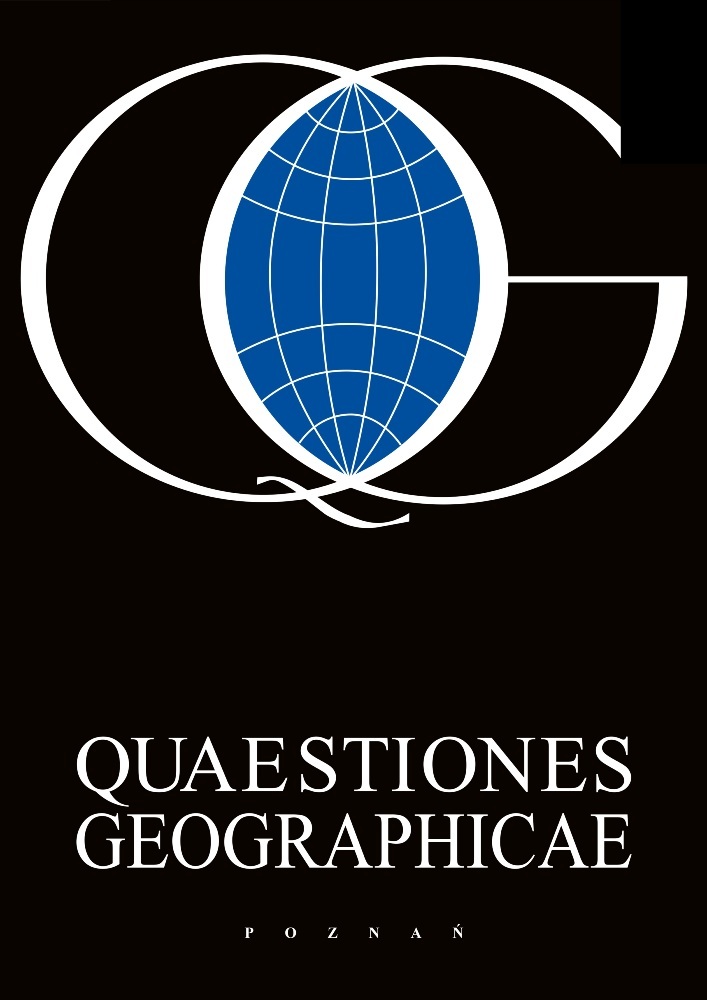Abstract
This paper analyses day-to-day changes of weather types and links these with synoptic situations, i.e. circulation types, air masses and weather fronts. The weather types were classified according to Woś (1999), while a calendar proposed by Niedźwiedź (2013) was used for synoptic situations. Weather records from Kraków were used covering the period 1961-2010. The frequency of all combinations of day-to-day weather type changes was calculated, identified using specific values of air temperature, cloudiness and precipitation. The analysis of the succession and frequency of the day-to-day changes was linked with the synoptic situations accompanying the change. It was found that the thermal weather types were relatively very stable and remained unchanged on the following day in 61.3% of cases, and that the synoptic situation also remained similar. Weather subtypes, identified with just cloudiness and precipitation, but not temperature, displayed much more day-to-day change in terms of frequency and scale. Synoptically it was the air mass change and/or the occurrence of atmospheric fronts, which tended to cause day-to-day weather type changes, while the impact of circulation was not always clear. Particular attention was devoted to sudden weather type changes caused primarily by dramatic air temperature fluctuations.
References
Ahas R., Aasa A., Silm S., Roosaare J., 2005. Seasonal indicators and seasons of Estonian landscapes. Landscape Research 30: 173-191.
Bogucki J., Woś A., 1994. Typy pogody a typy cyrkulacji atmosferycznej w rejonie Poznania. Badania Fizjograficznenad Polską Zachodnią Seria A, 45: 25-42.
Brown P.R., 2004. Weather types associated with extreme temperatures in England. Part 1: Maximum temperatures. Journal of Meteorology 29(294): 358-365.
Chubukov Ł.A., 1949. Kompleksnaja klimatołogia. Izdatielstwo Akademii Nauk SSSR, Moskwa-Leningrad.
Chubukov Ł.A., 1962. Sowriemiennyje osnowy tierieticzeskowo i prikładnowo ispolzowanija kompleksnoj klimatołogii. Trudy Wsiesojuznowo Naucznowo MietieorołogiczeskowoSowieszczanija 4: 59-63.
Fedorov E.E., 1925. Opyt izuczenia pogody miesaca po pogodam otdielnych dniej. Żurnał Gieofiziki i Meteorologii. 2(3-4): 5-16.
Howe G.F., 1925. The summer and winter weather of selected cities in North America. Monthly Weather Rev. 10: 427-429.
Kaszewski B., 1984. Typy cyrkulacji a klasy pogody (naprzykładzie danych z Lublina za okres 1951-1975). Sympozjum Naukowe, Skierniewice 1984: 55-56.
Kaszewski B.M., 1992. Typy cyrkulacji a typy pogody w Polsce. Rozprawy Habilitacyjne Wydziału Biologii i Nauk o Ziemi UMCS, 42. Lublin.
Maheras P., 1984. Weather-type classification by factor analysis in the Thessaloniki area. Int. J. Climatol. 4(4): 437-443.
Michailidou C., Maheras P., Arseni-Papadimititriou A., Kolyva-Machera F., Anagnostopoulou C., 2009a. A study of weather types at Athens and Thessaloniki and their relationship to circulation types for the cold-wet period, part I: Two-step cluster analysis. Theor. Appl. Climatol. 97(1-2): 163-177.
Michailidou C., Maheras P., Arseni-Papadimititriou A., Kolyva-Machera F., Anagnostopoulou C., 2009b. A study of weather types at Athens and Thessaloniki and their relationship to circulation types for the cold-wet period, part II: Discriminant analysis. Int. J. Climatol. 97(1-2): 179-194.
Nagórska D., 1998. Termiczne typy pogody w Koszalinie a typy cyrkulacji atmosferycznej. Badania Fizjograficznenad Polską Zachodnią Seria A, 49: 163-169.
Nichols E.S., 1925. A classification of weather types. MonthlyWeather Rev. 10: 431-434.
Niedźwiedź T., 1981. Sytuacje synoptyczne i ich wpływ nazróżnicowanie przestrzenne wybranych elementów klimatuw dorzeczu górnej Wisły. Rozprawy Habilitacyjne UJ, 58. Kraków.
Niedźwiedź T., 1983. The method of a synoptic-complex characterization of the climate presented upon the example of the Upper Vistula river basin. Zeszyty Naukowe UJ,Prace Geograficzne 57: 17-39.
Niedźwiedź T., 1988. Wybrane problemy klimatologii synoptycznej. Folia Geographica, Ser. Geographica-Physica 20: 121-134.
Niedźwiedź T., 2013. Kalendarz typów cyrkulacji atmosfery dlaPolski południowej. On-line: klimat.wnoz.us.edu.pl/ (accessed 17 January 2013).
Petrovič Š., 1968. Porovnanie typov počasia na Štrbskom Plese podla dynamicko klimatologického a komplexne klimatologického hodnotenia. Meteorologické Zprávy. 21(1): 12-15.
Piotrowicz K., 2010. Sezonowa i wieloletnia zmienność typów pogodyw Krakowie. IGiGP UJ, Kraków.
Sheridan S.C., 2002. The redevelopment of a weather-type classification scheme for North America. Int. J. Climatol. 22(1): 51-68.
Sheridan S.C., 2003. North American weather-type frequency and teleconnection indices. Int. J. Climatol. 23(1): 27-45.
Stefanicki G., Talkner P., Weber R.O., 1998. Frequency changes of weather types in the Alpine region since 1945. Theor. Appl. Climatol. 60(1-4): 47-61.
Switzer J., 1925. Weather types in the climate of Mexico, The Canal Zone, and Cuba. Monthly Weather Review 10: 434-437.
Twardosz R., Niedźwiedź T., Łupikasza E., 2011. The influence of atmospheric circulation on the type of precipitation (Kraków, southern Poland). Theor. Appl. Climatol. 104: 233-250.
Więcław M., 2004. Masy powietrza nad Polską i ich wpływ natypy pogody. Wydawnictwo Akademii Bydgoskiej, Bydgoszcz.
Woś A., 1999. Klimat Polski. PWN, Warszawa.
Zinkiewicz W., 1953. Zagadnienie kompleksów pogodowych. Annales UMCS Sectio B, 8(6): 312-341.
License
This content is open access.
